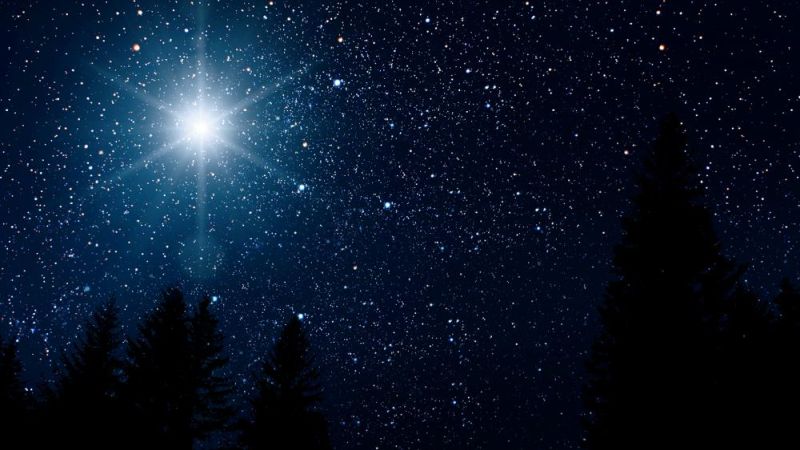
Is this astronomical event a sign of the Second Coming?
By UK Correspondent, Charles Gardner
Hold onto your seats! The “Star of Bethlehem” will appear in the sky just before Christmas, according to astronomers1.
No, this is not some sort of aerial nativity show or seasonal greeting – it’s the real thing! For the first time in 800 years, a conjunction of Jupiter and Saturn – the two largest planets in the solar system – will replicate the phenomenon thought to have led the Wise Men to the place of Christ’s birth.
Could this also be a portent of the imminent return of Jesus promised throughout the Scriptures and even by the Lord himself when he told his disciples that his coming again would be preceded by signs in the sun, moon and stars?
The two planets will appear closer to each other in the night sky during Christmas week than at any point in the past eight centuries, the astronomers say, and will be visible in the west near the horizon around sunset on December 21, when they will appear almost as a double planet system. They have been gradually getting closer to each other since the start of summer.
German astronomer Johannes Kepler wrote in 1614 that he believed the “Star of Bethlehem” in the nativity story could have been a conjunction of Jupiter and Saturn while others have suggested that the Wise Men could have been following a triple alignment also involving Venus.
Even without Venus, we are assured of an impressive sight, best viewed on the equator but seen worldwide, though very low on the horizon from the UK.
It was after Jesus was born in Bethlehem that Wise Men (or Magi) from the east came to Jerusalem to ask: “Where is the one who has been born King of the Jews? We saw his star in the east and have come to worship him.”
The priests pointed to nearby Bethlehem because they knew the prophet Micah had indicated as much: “But you, Bethlehem Ephrathah, though you are small among the clans of Judah, out of you will come for me one who will be ruler over Israel, whose origins are from of old, from ancient times.” –Micah 5:2.
The star the Magi had seen in the east duly went ahead of them “until it stopped over the place where the child was” — Matt 2:9. And Matthew’s gospel adds: “When they saw the star, they rejoiced with exceeding great joy.” (KJV)
In addition, Isaiah prophesied that a virgin would give birth to a son, who was to be called Immanuel, which means God with us. (Isa 7:14) In other words, God himself had taken on human flesh to live among his people.
For this reason, it is likely that he was born, not in midwinter, but during the autumn Jewish Feast of Tabernacles, which celebrates God’s presence with his people as they wandered in the wilderness. This does, however, mean that he will have been conceived in mid-December, rendering the angelic announcement to Mary of her miraculous pregnancy particularly appropriate (Luke 1:26-38).
Jesus grew up and demonstrated what God was like in every way, and yet suffered and died at the hands of wicked men before being raised to life. He also promised that he would come again, not this time as a suffering servant crucified for the sins of the world, but as the returning King of Kings to establish his eternal rule. As Charles Wesley put it in his great hymn “Lo, he comes with clouds descending”, it would be a case of God himself appearing on earth to reign!
But how would we know that his return is near? Jesus said there would be wars, famines, earthquakes and pestilences, even “fearful events and great signs from heaven,” adding: “There will be signs in the sun, moon and stars…men will faint from terror, apprehensive of what is coming on the world, for the heavenly bodies will be shaken. At that time, they will see the Son of Man coming in a cloud with power and great glory.” — Luke 21:11,25-27
Jews today still celebrate Tabernacles (as do many Christians, who gather in Jerusalem for the festival each year – until Covid) and do so by erecting temporary shelters in their gardens or balconies, perhaps covered by palm leaves, to remind them of God’s protection and miraculous provision in the desert.
It makes perfect sense that Jesus will return, just as he was probably born, during the Feast of Tabernacles which ultimately celebrates the ‘dwelling of God with men’ (see Rev 21:3). It’s significant that this feast will be mandatory for all nations during the coming thousand-year reign of Christ when the survivors from all the nations who have attacked Jerusalem will be expected to make an annual pilgrimage there, with non-compliance leading to drought. (Zech 14:16f)
As we focus on the incarnation of Christ this year and make room for him in our hearts, let us also watch and be ready to welcome his return. Look to the Star of Bethlehem. He is coming back very soon. Come, Lord Jesus!
1MailOnLine, December 4, 2020, by Ryan Morrison and Ian Randall







Come soon, Lord Jesus !!! And keep Your church awake, particular in the imperfect and fearful times we are living in… May these signs be an eye opener, even for the unbeliever.. So for the world to see !!! That they also might know You.. Come soon Lord Jesus , Your bride and the invited ones are waiting . We love You Lord, even if You would ask us three times , like You asked Peter…You know our hearths…we love You !!!
Thanks, Charles, for your faith-inspiring article. I once read a variation of your theory about the conjunction of planets=star. The wise men were astrologers in the ‘east’ – ? Persia? They believed the heavens mirrored the kingdoms of the earth. When they saw an astrologically significant feature, “his star” (Matt 2:2), in that segment of the sky that denoted Judea, they astrologically interpreted this to mean “a new king is born in Judea”. They followed their interpretation of the star. They did not follow the star. If they had they would have gone straight to Bethlehem. Instead they went to Herod’s palace in Jerusalem, where a new king was likely to be found. From there it was the Jewish Scripture that directed them to Bethlehem – not the star. Herod ascertained ‘the exact time the star had appeared’ in the Judea segment of the heavens (Matt 2:7). This star had appeared in their home-town in the East less than “two years” previously (Matt 2:16). They’d been on the road a long time. It was as they were on their way to Bethlehem that the star reappeared and visually guided them to the ‘house’ (not the stable) where “the child” (not the baby) Jesus was. There they worshiped Jesus and gave him their gifts. (Matt 2:9, 10,11)